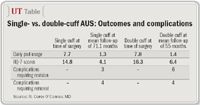Article
Double-vs. single-cuff AUS: Similar long-term outcomes
Atlanta-A study of patients receiving a double-cuff artificial urinary sphincter (AUS) shows encouraging short-term outcomes, but a second, longer-term study comparing single-cuff and double-cuff AUS indicates comparable outcomes but a greater complication rate with the double-cuff version.

Both studies were presented in a poster session at the AUA annual meeting here, and both studied the use of the AMS 800 artificial urinary sphincter (American Medical Systems, Minnetonka, MN).
The encouraging short-term data came from a multicenter study. Seetharaman Ashok, MD, of Brown University, Providence, RI, and colleagues conducted a retrospective review of 73 patients receiving a double-cuff AUS from 2002 to 2005 at one of four different institutions.

Of the 73 patients, 13 patients were excluded due to lack of follow-up, leaving 60 for analysis. Average age of the patients was 70 years, and average follow-up was 20 months (range, 2 to 60 months). A total of 45 patients (75%) had stress urinary incontinence resulting from radical prostatectomy; 12 had undergone radiation therapy for prostate cancer or transurethral resection of prostate for BPH; one patient had been surgically treated for rectal cancer; and two patients had pelvic crush injury. Patients were contacted by telephone and responded to a validated questionnaire.
Of the 60 patients, 16 (27%) received the procedure as salvage therapy, and 44 (73%) received it as primary therapy. Prior to AUS placement, about half of the patients (48%) reported severe incontinence (more than five pads/day), while average pad use for all patients was four pads/day. By contrast, after AUS placement, average pad use was one pad/day (range, zero to five). Average time to leak was 8 months (range, 2 to 24 months).
A total of 10 patients (17%) had cuff erosion, two (3%) had mechanical failure, three (5%) experienced infection, and two (3%) had urethral atrophy. Two of the three patients who had infection had the device removed, with one undergoing staged replacement. Of the 10 patients with cuff erosion, eight had the double-cuff AUS placed as a salvage procedure.
About half of the patients (53%) were completely dry, and 24 (40%) experienced significant improvement, defined as the daily use of less than half the number of pads used before AUS placement.
"These results suggest that we can easily and successfully place the double-cuff AUS with a success rate of over 90%, but there is also a fair share of erosions, although the rate of erosions seemed to be much less with the double-cuff compared with the single-cuff AUS," Dr. Ashok said.
The biggest advantage of the double-cuff AUS is that it dissipates pressure that occurs with a single cuff.
"A cuff reduces blood supply, causing the tissue to undergo atrophy and erosion," Dr. Ashok said. "By inserting two cuffs, less pressure is caused in each area, which means less chance of tissue atrophy, reducing the risk of erosion. Also, because the cuffs are in two different places, there is likely to be greater success in terms of continence."
However, the second study, which had an average of 71.1 months, found less encouraging results with the double-cuff AUS.




